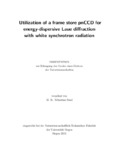Citation link:
https://nbn-resolving.org/urn:nbn:de:hbz:467-7555| DC Field | Value | Language |
|---|---|---|
| dc.contributor.author | Send, Sebastian | - |
| dc.date.accessioned | 2019-09-02T10:00:36Z | - |
| dc.date.available | 2013-08-29T12:12:12Z | - |
| dc.date.available | 2019-09-02T10:00:36Z | - |
| dc.date.issued | 2013 | - |
| dc.description.abstract | The use of highly brilliant synchrotron radiation provided by third-generation storage rings allows precise structure analyses of crystalline materials by means of X-ray diffraction. However, a variety of experiments is limited on the part of presently available detectors. The possibility to measure simultaneous position-, energy-, and time-resolved diffraction signals of the sample is offered for the first time by pnCCD systems developed at the Max-Planck-Institute Halbleiterlabor. The principle of a pnCCD is based on the electron-hole pair creation within a fully sideward depleted silicon layer by incident X-rays. The present work describes the general limitations of pnCCDs used for diffraction experiments with white synchrotron radiation. In that respect, both the achievable position, energy, and time resolution of single photons in the X-ray spectroscopy mode and the detector response in the integration mode are of considerable importance. The energy resolution of the pnCCD is investigated in the energy range between 6 keV and 20 keV by means of X-ray fluorescence spectroscopy. The experimental determination of the maximum number of storable charges per pixel, which defines the dynamic range of the detector, relies on analyses of the count rate behavior in the case of single-pixel illumination with intense monochromatic X-rays. In the second part of the work, the potential of pnCCD systems for structure analyses is demonstrated within the scope of energy-dispersive Laue diffraction experiments on tetragonal hen egg-white lysozyme crystals. The evaluation of the simultaneously measured spot positions and energies enables a calculation of the conventional unit cell from a single Laue pattern. This result is independent of the sample orientation, applicable to polycrystalline materials without restriction, and can be obtained without additional information about the sample. In this sense, pnCCD systems allow a fast characterization of polycrystals by means of white-beam Laue diffraction. The determination of integrated Bragg peak intensities is based on a statistical analysis of pile-up events generated by spatially overlapping charge clouds associated with different photons. The developed methods use the fact that the distribution of detected photon numbers is given by Poisson statistics. In this way, structure-factor amplitudes can be extracted from the pnCCD data sets and used for a structure refinement on an atomic level. | en |
| dc.description.abstract | Die Verwendung hochbrillianter Synchrotronstrahlung, die von Speicherringen der dritten Generation bereitgestellt wird, erlaubt präzise Strukturanalysen von kristallinen Materialien mit Hilfe der Röntgenbeugung. Allerdings ist eine Vielzahl von Experimenten von Seiten der gegenwärtig verfügbaren Detektoren begrenzt. Die Möglichkeit, Beugungssignale der Probe gleichzeitig orts-, energie- und zeitaufgelöst nachweisen zu können, bieten erstmalig am Halbleiterlabor des Max-Planck-Institutes entwickelte pnCCD-Systeme mit Bildspeicherauslese. Das Funktionsprinzip eines pnCCDs basiert auf der Erzeugung von Elektron-Loch-Paaren innerhalb einer vollständig seitwärts verarmten Silizium-Schicht bei Röntgeneinfall. Die vorliegende Arbeit beschreibt die allgemeinen Beschränkungen bei der Anwendung von pnCCDs für Beugungsexperimente mit weißer Synchrotronstrahlung. Dabei spielen sowohl die erreichbare Orts-, Energie- und Zeitauflösung einzelner Photonen im Spektroskopiemodus als auch das Verhalten des Detektors im Integrationsmodus eine wichtige Rolle. Die Energieauflösung des pnCCDs wird zunächst anhand fluoreszenzspektroskopischer Messungen im Energiebereich zwischen 6 keV und 20 keV untersucht. Die experimentelle Bestimmung der maximalen innerhalb eines Pixels speicherbaren Ladungsmenge, die den Dynamikbereich des Detektors festlegt, beruht auf Analysen des lokalen Zählratenverhaltens bei Beleuchtung eines einzelnen Pixels mit intensiver monochromatischer Röntgenstrahlung. Im zweiten Teil der Arbeit wird das Potenzial von pnCCD-Systemen für Strukturanalysen im Rahmen von energiedispersiven Lauebeugungsexperimenten an tetragonalen Kristallen aus Hühnereiweiß-Lysozym demonstriert. Dabei ermöglicht die Auswertung simultan gemessener Reflexpositionen und -energien eine Berechnung der konventionellen Elementarzelle mittels einer einzigen Laue-Aufnahme. Dieses Ergebnis ist unabhängig von der Probenorientierung, ohne Einschränkungen auf polykristalline Materialien anwendbar und kann ohne zusätzliche Informationen über die Probe gewonnen werden. In diesem Sinne erlauben pnCCD-Systeme eine schnelle Charakterisierung von Polykristallen mit Hilfe der Weißstrahl-Lauebeugung. Die Bestimmung integraler Reflexintensitäten basiert auf einer statistischen Analyse von Pile-up-Ereignissen, bei denen sich die Signalamplituden verschiedener Photonen räumlich überlagern. Die dazu entwickelten Methoden verwenden, dass die Verteilungen detektierter Photonenzahlen der Poisson-Statistik genügen. Damit können Strukturfaktoramplituden aus den pnCCD-Datensätzen extrahiert und für eine Strukturverfeinerung auf atomarem Niveau verwendet werden. | de |
| dc.identifier.uri | https://dspace.ub.uni-siegen.de/handle/ubsi/755 | - |
| dc.identifier.urn | urn:nbn:de:hbz:467-7555 | - |
| dc.language.iso | en | en |
| dc.rights.uri | https://dspace.ub.uni-siegen.de/static/license.txt | de |
| dc.subject.ddc | 530 Physik | de |
| dc.subject.other | semiconductor detector | en |
| dc.subject.other | X-ray diffraction | en |
| dc.subject.other | structure analysis | en |
| dc.subject.other | crystallography | en |
| dc.subject.swb | Synchrotronstrahlung | de |
| dc.subject.swb | Halbleiterdetektor | de |
| dc.subject.swb | Röntgenbeugung | de |
| dc.subject.swb | Kristallographie | de |
| dc.subject.swb | Strukturanalyse | de |
| dc.title | Utilization of a frame store pnCCD for energy-dispersive Laue diffraction with white synchrotron radiation | en |
| dc.title | Verwendung eines Bildspeicher-pnCCDs für energiedispersive Laue-Beugung mit weißer Synchrotronstrahlung | de |
| dc.type | Doctoral Thesis | de |
| item.fulltext | With Fulltext | - |
| ubsi.date.accepted | 2013-07-23 | - |
| ubsi.publication.affiliation | Fakultät IV - Naturwissenschaftlich-Technische Fakultät | de |
| ubsi.subject.ghbs | UIGD | - |
| ubsi.subject.ghbs | UIOS | - |
| ubsi.type.version | publishedVersion | de |
| Appears in Collections: | Hochschulschriften | |
This item is protected by original copyright |
Page view(s)
774
checked on Nov 25, 2024
Download(s)
293
checked on Nov 25, 2024
Google ScholarTM
Check
Items in DSpace are protected by copyright, with all rights reserved, unless otherwise indicated.


